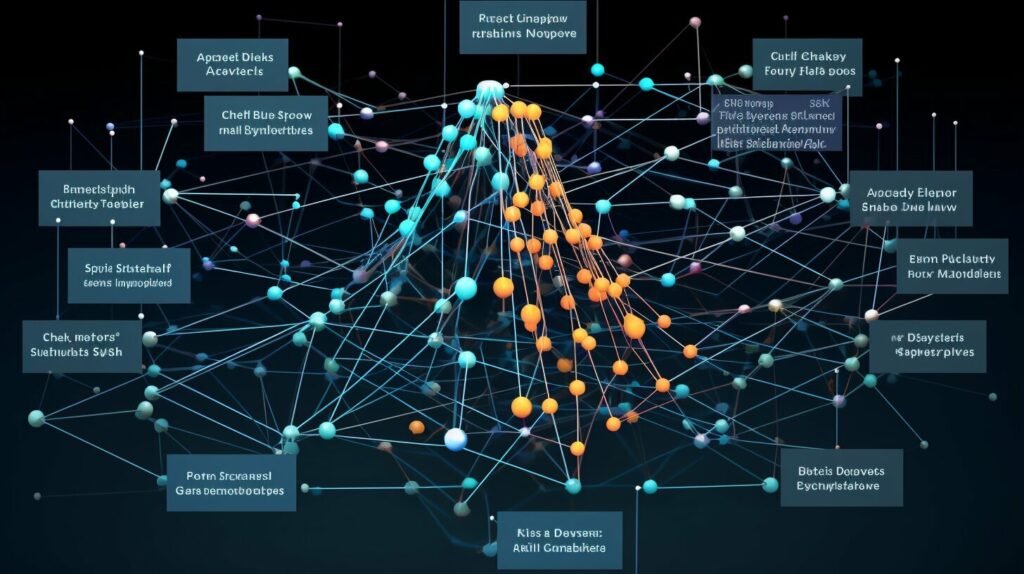Welcome to our friendly guide on data analysis, where we will help you understand the power of extracting key insights from your data. In today’s data-driven world, making informed decisions and predicting trends is crucial for businesses and professionals alike.
Professionals in various sectors, such as data analysts, business analysts, project managers, digital marketers, and data scientists, rely on data analysis tools to uncover trends, optimize operations, enhance decision-making, and build new models. Choosing the right data analysis tool is essential for maximizing productivity and achieving professional goals.
Key Takeaways:
- Data analysis is crucial for making data-driven decisions and predicting trends.
- Professionals from different sectors rely on data analysis tools to optimize operations and enhance decision-making.
- Choosing the right data analysis tool is essential for maximizing productivity and achieving professional goals.
- Data analysis tools can be categorized into data mining and data visualization tools.
- A data analytics framework provides a structured approach to processing and interpreting data.
What are Data Analysis Tools?
Data analysis tools are software programs, applications, and aids that professionals use to analyze data sets and gather, interpret, and visualize data. These tools play a crucial role in helping professionals uncover trends, insights, and patterns in complex data, enabling them to make data-driven decisions and identify valuable opportunities.
Data analysis tools have diverse applications across various sectors, including manufacturing, life sciences, energy, healthcare, and more. They allow professionals to extract key information from raw data, perform data mining to discover hidden patterns and relationships, and visualize the data in meaningful ways.
With data analysis tools, professionals can effectively interpret large amounts of data, identify trends, make accurate predictions, and optimize business operations. These tools provide the necessary functionality to process complex data sets, manipulate variables, and generate statistical models that support decision-making processes.

The Importance of Data Analysis Tools
“Data analysis tools help professionals uncover trends, insights, and patterns in complex data, enabling them to make data-driven decisions and identify valuable opportunities.”
Data analysis tools have revolutionized the way professionals handle data. By automating and streamlining the data analysis process, these tools save time and effort, allowing professionals to focus on extracting meaningful insights from the data rather than getting lost in the intricacies of data processing.
Moreover, data analysis tools provide interactive data visualization capabilities that make it easier for professionals to communicate their findings and present complex information in a clear and engaging manner. This visual representation of data not only helps professionals understand the data better but also facilitates collaboration and decision-making within the organization.
| Data Analysis Tool | Application |
|---|---|
| RapidMiner | Data mining and predictive analytics |
| Tableau | Data visualization and business intelligence |
| Google Charts | Data visualization for web applications |
| Datawrapper | Data visualization for journalists and bloggers |
As data continues to grow in volume, velocity, and variety, the need for robust data analysis tools becomes even more critical. These tools empower professionals to harness the vast amount of data available to them, unlock valuable insights, and drive innovation and growth in their respective fields.
Who Uses Data Analysis Tools and Why?
Data analysis tools are utilized by professionals in various roles to extract valuable insights from data and drive data-driven decisions. Let’s take a look at how different professionals leverage these tools to maximize their efficiency and achieve their goals.
Data Analysts
Data analysts rely heavily on data analysis tools to uncover trends, patterns, and insights hidden within large datasets. These tools help them process and organize data, perform statistical analysis, and generate visualizations to communicate findings effectively. By using data analysis tools, data analysts can support decision-making processes, identify areas for improvement, and contribute to the overall success of their organizations.
Business Analysts and Project Managers
Business analysts and project managers use data analysis tools to optimize operations, improve profitability, and solve complex business problems. These tools enable them to analyze data related to sales, customer behavior, market trends, and other key metrics. By leveraging data analysis tools, business analysts and project managers can make informed decisions, identify growth opportunities, and drive the success of their projects and organizations.
Digital Marketers
Digital marketers utilize data analysis tools to understand consumer behavior, track campaign performance, and optimize marketing strategies. These tools provide insights into website traffic, social media engagement, email marketing metrics, and more. By analyzing this data, digital marketers can make data-driven decisions, target the right audience, and craft effective marketing campaigns that drive results.
Data Scientists
Data scientists use advanced data analysis tools to build predictive models, solve complex problems, and extract insights from large and diverse datasets. These tools enable them to perform advanced statistical analysis, machine learning algorithms, and data visualization techniques. By leveraging data analysis tools, data scientists can uncover valuable insights, drive innovation, and contribute to the development of cutting-edge solutions.
Overall, data analysis tools are essential for professionals across various industries, including data analysts, business analysts, project managers, digital marketers, and data scientists. These tools empower them to make data-driven decisions, identify trends and insights, drive profitability, and contribute to the overall success of their organizations.
10 Data Analysis Tools and When to Use Them
Data analysis tools play a crucial role in extracting insights and making informed decisions based on data. Whether you are a data analyst, business analyst, or data scientist, having the right tools can enhance your productivity and effectiveness. In this section, we will explore 10 popular data analysis tools and when to use them.

For data mining, three commonly used tools are RapidMiner, Orange, and KNIME. RapidMiner offers a user-friendly interface and a wide range of data mining algorithms, making it suitable for beginners and experienced professionals alike. Orange, on the other hand, combines data mining and visualization features, allowing users to gain insights while exploring their data. KNIME is known for its modular approach, enabling users to create custom workflows and integrate different data analysis techniques.
When it comes to data visualization, Tableau, Google Charts, and Datawrapper are popular choices. Tableau offers powerful visualization capabilities, allowing users to create interactive dashboards and reports. Google Charts provides a wide range of charts and graphs that can be embedded into websites and applications. Datawrapper focuses on simplicity and ease of use, making it ideal for creating visually appealing data visualizations quickly.
These tools are not limited to specific industries or roles. They are valuable for various data analysis tasks, including business analytics, market research, and data-driven decision-making. By utilizing the right data analysis tool at the right time, professionals can extract valuable insights and drive successful outcomes.
What is a Data Analytics Framework?
A data analytics framework is a structured approach that guides data professionals through the process of processing and interpreting large amounts of data. It encompasses steps such as data collection, data processing and cleansing, data storage, data analysis and mining, data visualization, insight generation, and decision-making. A robust data analytics framework ensures consistency, accuracy, and clarity in the data journey, enabling organizations to harness the full potential of their data and make informed decisions.
A data analytics framework provides a systematic structure for data professionals to follow, ensuring that each step in the data journey is executed efficiently and effectively. By adopting a structured approach, organizations can manage and analyze large volumes of data in a consistent and organized manner. This approach also enables data professionals to identify patterns, trends, and insights that may otherwise go unnoticed.
With a data analytics framework in place, organizations can ensure that data is collected from multiple sources, cleaned and processed to remove any inconsistencies or errors, stored securely and efficiently, analyzed to uncover valuable insights, visualized in a clear and understandable manner, and ultimately used to make informed decisions. By following a structured framework, organizations can capitalize on the power of data analytics to drive their success and gain a competitive advantage in their industry.

Key Components of a Data Analytics Framework
| Component | Description |
|---|---|
| Data Collection | Gathering data from various sources, such as databases, APIs, and external sources. |
| Data Processing and Cleansing | Ensuring the data is accurate, consistent, and free from errors or inconsistencies. |
| Data Storage | Storing the data in a secure and accessible manner, such as in databases or cloud storage. |
| Data Analysis and Mining | Applying statistical and analytical techniques to uncover patterns, trends, and insights in the data. |
| Data Visualization | Presenting the data in a visually appealing and understandable format, such as charts or dashboards. |
| Insight Generation | Deriving meaningful insights from the data analysis to inform decision-making. |
| Decision-Making | Using the insights generated from the data analysis to make informed decisions. |
Integral Components of a Data Analytics Framework
A data analytics framework consists of several integral components that work together to ensure the success of the data analysis process. These components include:
Data Collection and Acquisition
This component involves gathering relevant data from various sources. It may include data from internal databases, external APIs, surveys, or social media platforms. The data collection process should be thorough and comprehensive, ensuring that all necessary data points are captured.
Data Processing and Cleansing
After collecting the data, it is essential to process and cleanse it to remove any inconsistencies, errors, or missing values. This step ensures that the data is accurate and reliable for analysis. Data processing techniques may include data transformation, normalization, and outlier detection.
Data Storage
Storing data in a secure and accessible manner is crucial for a data analytics framework. This component involves choosing the appropriate storage solution, such as a database or data warehouse, and ensuring data integrity and confidentiality.
Data Analysis and Mining
Once the data is cleaned and stored, the next step is to analyze and mine the data for insights. This component involves applying statistical techniques, machine learning algorithms, and data mining methods to uncover meaningful patterns, trends, and relationships within the data.
Data Visualization
Data visualization is an essential component of a data analytics framework as it enables stakeholders to easily interpret and understand the insights derived from the data. Visual representations such as charts, graphs, and dashboards make it easier to identify patterns and trends, facilitating effective decision-making.
Insight Generation
Insight generation involves interpreting the analyzed data and extracting valuable insights. This component focuses on identifying actionable findings that can drive business strategy, improve operational efficiency, or enhance customer experience.
Decision-Making
The final component of a data analytics framework is decision-making. Once insights are generated, stakeholders can use them to make informed decisions that drive business success. These decisions may include optimizing processes, refining marketing strategies, or allocating resources.
By integrating these integral components into their data analytics framework, organizations can maximize the value of their data and make data-driven decisions that lead to improved performance and competitive advantage.
Tips to Utilize Data Analytics Frameworks
Data analytics frameworks serve as essential tools for professionals in extracting insights from data and making informed decisions. To maximize the effectiveness and efficiency of these frameworks, there are several tips to keep in mind.
Set Clear Objectives
Before diving into data analysis, it’s crucial to establish clear objectives. Define what you hope to achieve with the data and determine the specific insights you are seeking. By setting clear goals, you can focus your analysis and ensure that the framework aligns with your objectives.
Prioritize Data Quality
Data quality is paramount in data analysis. Ensure that the data being collected is accurate, reliable, and relevant to the analysis at hand. Implement data cleansing processes to eliminate any errors or inconsistencies. By prioritizing data quality, you can trust the insights generated by the framework.
Maintain Consistency
Consistency is key in data analysis. Establish standardized processes for data collection, storage, analysis, and visualization. This ensures that the framework is conducted in a consistent manner and allows for easy replication and comparison of results. Consistency also helps maintain the integrity of the data and facilitates collaboration among team members.
Visualize Data
Data visualization is an effective way to communicate insights and findings. Utilize data visualization techniques to present data in a clear and engaging manner. Visualizations can help uncover patterns, trends, and relationships within the data, making it easier for decision-makers to understand and act upon the insights generated.
Seek Feedback and Collaboration
Collaboration is invaluable in data analysis. Seek feedback from colleagues, stakeholders, and domain experts to ensure that the insights generated are relevant and meaningful. Encourage collaboration within the team by sharing findings, discussing methodologies, and incorporating diverse perspectives. This collaborative approach can enhance the quality and applicability of the insights derived from the data analytics framework.
Ensure Data Security
Data security should be a top priority when working with data analytics frameworks. Implement measures to protect sensitive data, including encryption, access controls, and regular backups. Adhere to relevant data protection regulations and guidelines to safeguard the privacy and confidentiality of the data being analyzed.
Stay Updated with the Latest Trends
Data analytics is an ever-evolving field, with new tools, techniques, and methodologies emerging regularly. Stay updated with the latest trends and advancements in data analytics to ensure that your framework remains effective and relevant. Attend conferences, participate in webinars, and engage in continuous learning to stay abreast of industry developments.
By following these tips, you can effectively utilize data analytics frameworks, harness the power of data, and make data-driven decisions that propel your organization forward.

Conclusion
In today’s data-driven world, making informed decisions is crucial for the success of any organization. Data analysis plays a vital role in extracting valuable insights from data, enabling us to uncover trends, identify opportunities, and drive data-driven success. One powerful tool that empowers data analysts in this process is Power BI.
Power BI is an advanced data visualization tool that allows us to transform raw data into meaningful and actionable insights. With its user-friendly interface and real-time visualization capabilities, Power BI enables us to explore data from a wide range of sources and create visually compelling reports.
Moreover, Power BI offers seamless integration with other Microsoft tools, making it easier for us to access and analyze data. Its cost-effectiveness, mobile accessibility, and collaborative features further enhance its usability and effectiveness.
By harnessing the capabilities of Power BI, organizations can improve their performance, make informed decisions, and achieve data-driven success. With the ability to publish and share reports, data analysts can effectively communicate their findings to stakeholders and drive impactful change.
FAQ
What are data analysis tools?
Data analysis tools are software programs, applications, and aids that professionals use to analyze data sets and gather, interpret, and visualize data.
Who uses data analysis tools and why?
Professionals in various sectors, such as data analysts, business analysts, project managers, digital marketers, and data scientists, use data analysis tools to uncover trends, optimize operations, enhance decision-making, and build new models.
What are some popular data analysis tools?
For data mining, three commonly used tools are RapidMiner, Orange, and KNIME. For data visualization, Tableau, Google Charts, and Datawrapper are popular choices.
What is a data analytics framework?
A data analytics framework is a structured approach that guides data professionals through the process of processing and interpreting large amounts of data, including steps such as data collection, processing, storage, analysis, visualization, insight generation, and decision-making.
What are the integral components of a data analytics framework?
The integral components of a data analytics framework include data collection and acquisition, data processing and cleansing, data storage, data analysis and mining, data visualization, insight generation, and decision-making.
How can I effectively utilize data analytics frameworks?
To effectively utilize data analytics frameworks, it is important to set clear objectives, prioritize data quality, maintain consistency in data collection and analysis processes, visualize data, regularly review and update the framework, seek feedback, act on the insights, ensure data security, and stay updated with the latest trends in data analytics.
What is Power BI?
Power BI is a powerful data visualization tool that helps data analysts turn raw data into meaningful insights and actionable decisions. It provides a user-friendly interface, real-time data visualization, integration with other Microsoft tools, a wide range of data sources, cost-effectiveness, mobile accessibility, collaboration features, and the ability to publish and share reports.











